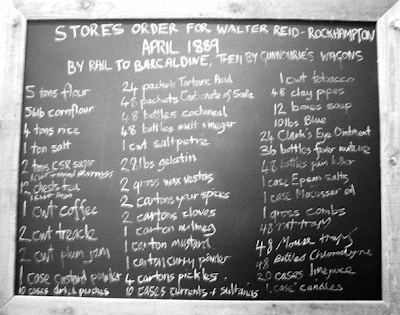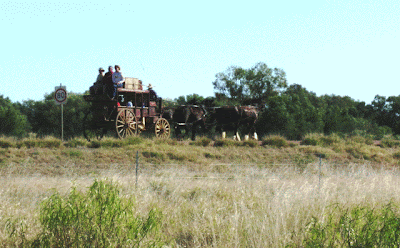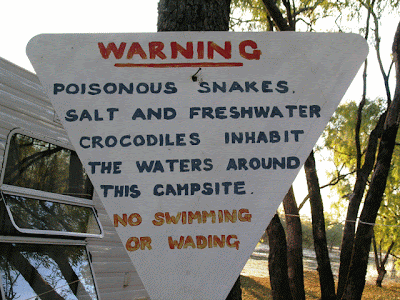Our only appointment on our two month journey was a week supporting the Cairns to Karumba (Coast to Coast) bicycle ride. We had 150 riders and 100 supporters on the 780 Km trip. Overall the ride raised more than $60,000 to support charities such as RFDS , burns unit for children in Cairns and charities for kids in the bush throughout the Cape and Gulf country.
The Coast to Coast cycle ride started on Sunday morning and we were joined by Dell’s brother Jim and nephew and niece, Robert and Kate plus assorted friends. We were rear escort vehicle for Pack 3 which meant we had to protect the back of the pack and communicate by radio with the lead vehicle letting them know when vehicles wanted to pass.
The most challenging part of the route was from Cairns to Mt Garnet. We had an excellent volunteer police escort who led convoys of waiting vehicles past the riders. He also led the road trains through. A paramedic in his ambulance was excellent at sitting between the packs and warning vehicles approaching from the rear.
Once we had passed Mt Garnet the drivers were great. Most of the big trucks tended to say “No rush, I’ll hang back until you are ready.” It was disappointing that we received some unpleasant abuse behind the anonymity of the radios on day 1 and the morning of day 2. It appeared to come from suburban “blokey” blokes who had bought their 4WD plus $$$ of extras and objected to “selfish b******s on the road.” They clearly did not recognise the irony of their statements.
We had a lot of wonderful support from local people along the way.
Day 1 Mareeba Lions and Lionesses provided lunch.
Day 3 local families provided a sumptuous morning tea
Day 5 the “Grandmothers” from distance education families, with helpers, supplied a pasta lunch at Gilbert River.
They also sang a song the children had composed for the riders.
Gilbert River had a most amazing bridge that took a road train with no room to spare. If you were daft enough to be riding or walking over the bridge when a road train decided to come through then you would be blown over the side.
There were also two teams who provided drinks, fresh fruit and nuts along the way.
We stayed in different types of accommodation along the way. In Mt Garnet, we stayed in the rodeo ground and were able to use shelters that families had erected to use during the rodeos.
In other rodeo grounds we were mighty glad we had a rake – and so were one or two others. The Irish used to say that horse manure was “good clean dirt.” Opinions vary. One of the more challenging stops was Atherton Show Grounds with communal cold showers - one for each sex. As one of the ladies said, “I just took my glasses off and no one could see me.”
Most nights we had some form of entertainment such as “No Talent Contest” and singing round the fire.
The food throughout the whole trip was provided by the Road Kill Catering Company and was excellent. We had four choices each evening, cooked breakfasts and the makings of our packed lunches. They all wore ‘T’ shirts bearing the slogan “You kill it. We grill it.” When Richard commented on the slogan the cook replied that if a bike was able to kill something then it was probably small enough for them to grill.
We passed some beautiful countryside; lagoons with water lilies and birds, a wattle corridor that extended for several kilometres, wide open savannah and generally spectacular views. It was hard on the cyclists particularly with two days covering about 150 kms each. Spirits lifted when we set of from Normanton with the end in sight. There is a traditional photo shot with the riders perched on the largest recorded saltwater croc in the world, Krys – the Savannah King.



From Normanton main street it was 78 km ride to lunch at the Karumba Golf Club. We had been told that there were no prawns for lunch this year as we could not get a sponsor. However when we arrived there were plenty prawns. Geoff Mitchell, whose son Craig was riding in the lead pack, decided lunch on the final day had to have prawns to keep up the tradition. He agreed with his directors to sponsor the prawns and set off at dawn to buy them. After lunch it was an orderly ride to Karumba Point for the whole group. They were escorted by the police car with sirens and lights to announce their arrival.
Last group photo on the beach.
Our niece, Kate Boyd, had one last duty. Her brother Robert had promised to give her the bicycle she rode if she held it over her head in the sea. This was not without its challenges as there were quite a few crocs sighted regularly in the area. She turned even more white when Richard mentioned how cheap croc bait was in the bait shop (only joking). Being a good brother Robert supported her by standing in the sea with her.
We rounded the day off enjoying fish and chips whilst watching the sun set.
































































